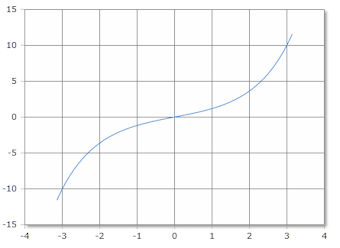Hyperbolic Sine
Online calculator for calculating the hyperbolic sine of an angle
Sinh Calculator
Universal Domain
The Sinh(x) or hyperbolic sine shows S-curve behavior for all real numbers.
Sinh Function Curve

The Sinh function shows S-curve behavior passing through origin with exponential growth.
Domain: ℝ, Range: ℝ
|
|
S-Curve Behavior of Sinh
The hyperbolic sine function exhibits characteristic S-curve properties:
- Domain: ℝ (all real numbers)
- Range: ℝ (all real numbers)
- Zero Point: Sinh(0) = 0
- Symmetry: Odd function Sinh(-x) = -Sinh(x)
- Growth: Exponential for large |x|
- Shape: Classic S-curve through origin
Exponential Representation of Sinh Function
The hyperbolic sine function is expressed through exponential functions:
Basic Formula
Difference of exponentials divided by 2
Growth Relation
Exponential growth for large arguments
Formulas for the Sinh Function
Definition
Exponential difference for all x ∈ ℝ
Hyperbolic Identity
Fundamental hyperbolic identity
Derivative
Derivative is hyperbolic cosine
Symmetry Property
Odd function (antisymmetric)
Addition Formula
Addition formula for hyperbolic sine
Special Values
Important Values
Universal Domain
Function defined everywhere
Zero Point
Function passes through origin
Properties
- Odd function
- S-curve shape
- Exponential growth
- Passes through origin
Growth Pattern
Exponential growth for large arguments
Applications
Relativity theory, engineering calculations, wave equations, mathematical modeling.
Detailed Description of the Sinh Function
Definition and Input
The hyperbolic sine function Sinh(x) is defined as the difference of exponential functions. It exhibits characteristic S-curve behavior passing through the origin with exponential growth for large arguments.
Input
The angle is given in degrees (full circle = 360°) or radians (full circle = 2π). The unit of measurement used is set using the Degrees or Radians menu. All real numbers are valid inputs.
Result
The result can be any real number. For large positive arguments the function grows exponentially, for large negative arguments it approaches negative infinity exponentially.
Using the Calculator
Enter any angle value. The Sinh function calculates the hyperbolic sine, which represents the S-curve growth pattern.
Mathematical Properties
Function Properties
- Domain: ℝ (all real numbers)
- Range: ℝ (all real numbers)
- Zero Point: Sinh(0) = 0
- Symmetry: Odd function Sinh(-x) = -Sinh(x)
S-Curve Properties
- Passes through origin (0, 0)
- Monotonically increasing function
- Exponential growth for large |x|
- S-shaped curve with inflection point at origin
Applications
- Special Relativity: Rapidity calculations
- Engineering: Catenary and suspension problems
- Wave Equations: Hyperbolic partial differential equations
- Mathematical Analysis: Complex function theory
Practical Notes
- No domain restrictions: accepts any real number
- Origin passage: Sinh(0) = 0
- Odd function: Sinh(-x) = -Sinh(x)
- S-curve: Characteristic exponential growth pattern
Calculation Examples
Small Values
Sinh(0) = 0
Sinh(0.5) ≈ 0.521
Sinh(1) ≈ 1.175
Negative Values
Sinh(-0.5) ≈ -0.521
Sinh(-1) ≈ -1.175
Sinh(-2) ≈ -3.627
Large Values
Sinh(5) ≈ 74.20
Sinh(10) ≈ 11013
Exponential growth
Physics and Engineering Applications
Special Relativity
Rapidity:
v = c · tanh(φ), γ = cosh(φ)
Hyperbolic motion in spacetime
Application: Particle acceleration and relativistic kinematics.
Wave Equations
Hyperbolic PDEs:
Wave propagation solutions
Vibration and oscillation analysis
Example: String vibrations and membrane oscillations.
Important Mathematical Relationships
Hyperbolic Identity
Fundamental Identity: Analogous to trigonometric identity.
Calculus Properties
Derivative: Derivative is hyperbolic cosine.
|
|
|
|